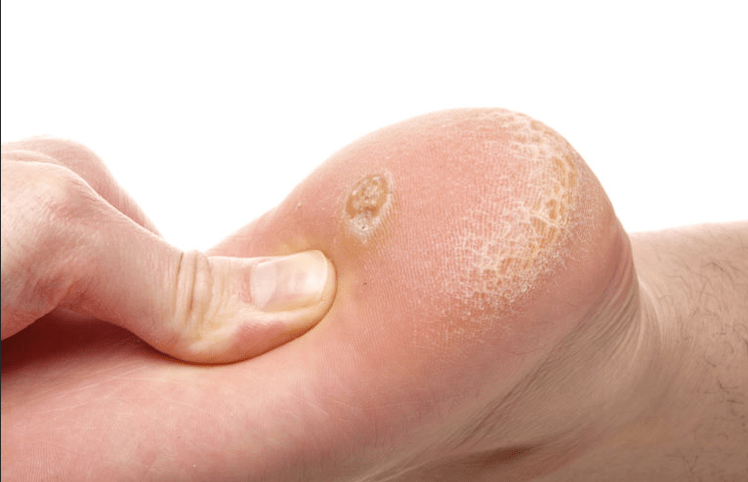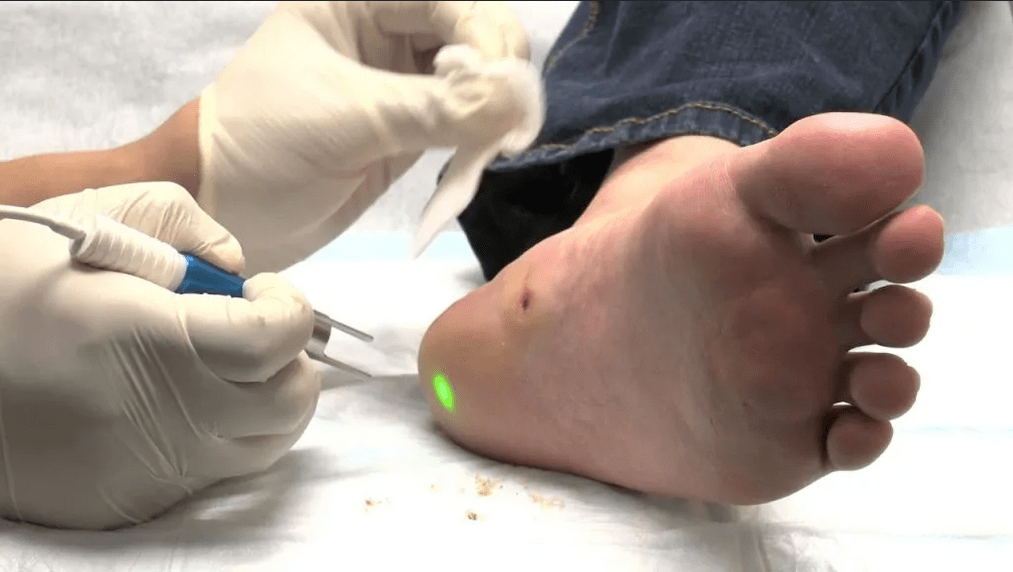Social wart - A solid and flat formation on the skin of the feet, slightly towering above its level and covered with a layer of keratinized epithelium. The main method for diagnosing a plantar wart is DermatoSkopiya. The location of the warp on the sole leads to its constant injury and the occurrence of pain during walking. For this reason, the plantar wart often requires treatment, although it can pass on its own. The removal methods include cryotherapy, electrocoagulation, removal by a radio wave apparatus or laser.

General information
The plantar wart refers to benign skin neoplasms and is approximately 34% of all warts. Dermatology is engaged in the diagnosis and treatment of warts. The use of folk methods of getting rid of warts and self -medication is extremely undesirable. The plantar wart has a root that is deeply going into the skin and its incomplete removal will lead to a new increase in the wart, and excessive damage to the surrounding tissues - to the appearance of warts in other parts of the body.
The causes of the subsidiary
Papillomas, condylomas and all kinds of warts (ordinary, flat, filamentary, plantar) have the same nature - infection of the body with the papilloma virus (HPV). The virus spreads among people through infected skin cells (in contact). The most favorable for him is a wet and warm environment. Therefore, infection of HPV often occurs in pools, saunas, baths and gyms. With a sufficiently strong functioning of the immunity of HPV in the human body, it abides in a latent state and does not give clinical manifestations. A failure in the immune system leads to the activation of the virus and the appearance on the skin of the above formations.
Excessive sweating (hyperhidrosis) or dry skin of the skin may contribute to the development of a plantar wart; uncomfortable shoes that cause compression or friction of the skin of the foot; various deformations of the foot (flat feet, deforming osteoarthrosis, arthritis of the small joints of the foot); Diseases leading to impaired trophic tissues of the foot (diabetes mellitus, varicose veins of the lower extremities, atherosclerosis, etc. ), damage to the skin of the foot.
Manifestations of a plantar wart
The plantar wart is a solid, clearly delimited seal on the sole. Most often, it has an oval or rounded shape and size of about 1-2 cm. Education by 1-3 mm protrudes above the total level of the skin. The color of the skin in the area of the plantar wart is usually not changed, but can be light brown or pink.
The surface of the wart at the beginning of its formation is smooth. Over time, it is covered with clasps of the keratinized epidermis, becomes rough and acquires a gray-yellow hue. Sometimes in the center of the plantar wart, Krateropodobnoe recess is noted. Black-brown points, which can often be seen on the surface of the wart, are due to Trombirivaniem superficial capillaries.
As a rule, the plantar wart is single. The appearance of subsidiaries indicates the high activity of the virus. Multiple warts give a mosaic drawing to the affected area of the sole, for which they were called "mosaic warts".
An independent disappearance of the plantar wart may be observed. In this case, there is no trace on the skin of the foot. But more often, due to constant injury, the resolution of the wart does not occur. Not painful in itself, it begins to cause significant discomfort and even sharp pain associated with friction and pressure of the wart on the sole of the shoes.
Diagnostics of a plantar wart
In its appearance, the plantar wart often resembles a corn or a section of skin hyperkeratosis. Only a professional dermatologist can distinguish it from these formations. For this, DermatoSkopiya is carried out. In order to better investigate the formation, the doctor pre -scrapping the upper layers of the keratinized epithelium. The absence of a skin pattern on the surface of education and the identification of a characteristic symptom of "thrombus capillaries" speak in favor of a plantar wart. Positive results of the PCR diagnosis to HPV confirm the patient Inficirovannost.
To determine the depth of the germination of the plantar wart, the patient is prescribed an ultrasound of the skin education. In case of suspicion of malignant nature, a consultation with a dermato oncologist is carried out. When identifying deformations and diseases of the foot, Podologa consultation is necessary.
Podoshvennuyu the wart is differentiated with Keratodermiei soles and palms with Raytera syndrome. The smaller size of education is not conical, but flat form, a symptom of "thrombic capillaries" and the lack of inflammatory changes around keratinized layers allow to distinguish the Podoshvennuyu wart from Keratodermi. Ladomary-sophisticated Sifiloidy have some similarity with the plantar wart. They are distinguished from the latter multiple, painlessness and characteristic arrangement in the form of rings or arcs, a positive RPR test for syphilis.
Treatment of plantar wart

The removal of the plantar wart is complicated by its deeper, in comparison with other types of warts, germination in the dermis. For this reason, electrocoagulation, for example, is not always suitable for getting rid of a wart. Its use is possible only in the case of a shallow arrangement of the plantar wart and is often complicated by the formation of the scar.
Good results are given by cryodestruction of the wart. Its result depends on the experience of the doctor, since too deep exposure can lead to healing of the wound with the formation of the scar, and too superficial to the relapse of the wart. After processing with liquid nitrogen at the site of the wart, a blister remains, which cannot be injured until its healing (about 7 days). Laser removal gives the best cosmetic result and allows you to regulate the depth of exposure in the most optimal way. Laser wart removal is carried out quickly and painlessly, and healing takes several days.
To remove the plantar wart, a radio wave method can also be used in which the wart is cut by the radio with a knife. At the same time, the vessels are cauterized, which prevents bleeding and the ingress of the virus from the wart into the blood. Surgical excision is suitable for large -sized plantar boards. It is carried out by ordinary scalpel under local anesthesia and can be complicated by the formation of the scar.
Prevention of the plantar wart
The primary prevention of the appearance of a plantar wart is to prevent HPV infection. Particular attention should be paid to mandatory wearing individual shoes in public showers, pools and baths. Of no small importance, especially for people with stop diseases, is proper care of the skin of the feet: regular pedicure, piling of the feet and their processing RazMyagChayuschimi by means.
Patients with the deformation of the stop should use orthopedic insoles, orthosis, and unloading corrector. With increased sweating of the feet, it is important to select shoes from natural materials and use drying products. With dryness and cracks on the skin of the soles, nutritious and moisturizers, therapeutic baths for the legs are needed.
Secondary prophylaxis of the plantar wart consists in prescribing the patient along with the removal of a wart of antiviral drugs and immuno correctors.























